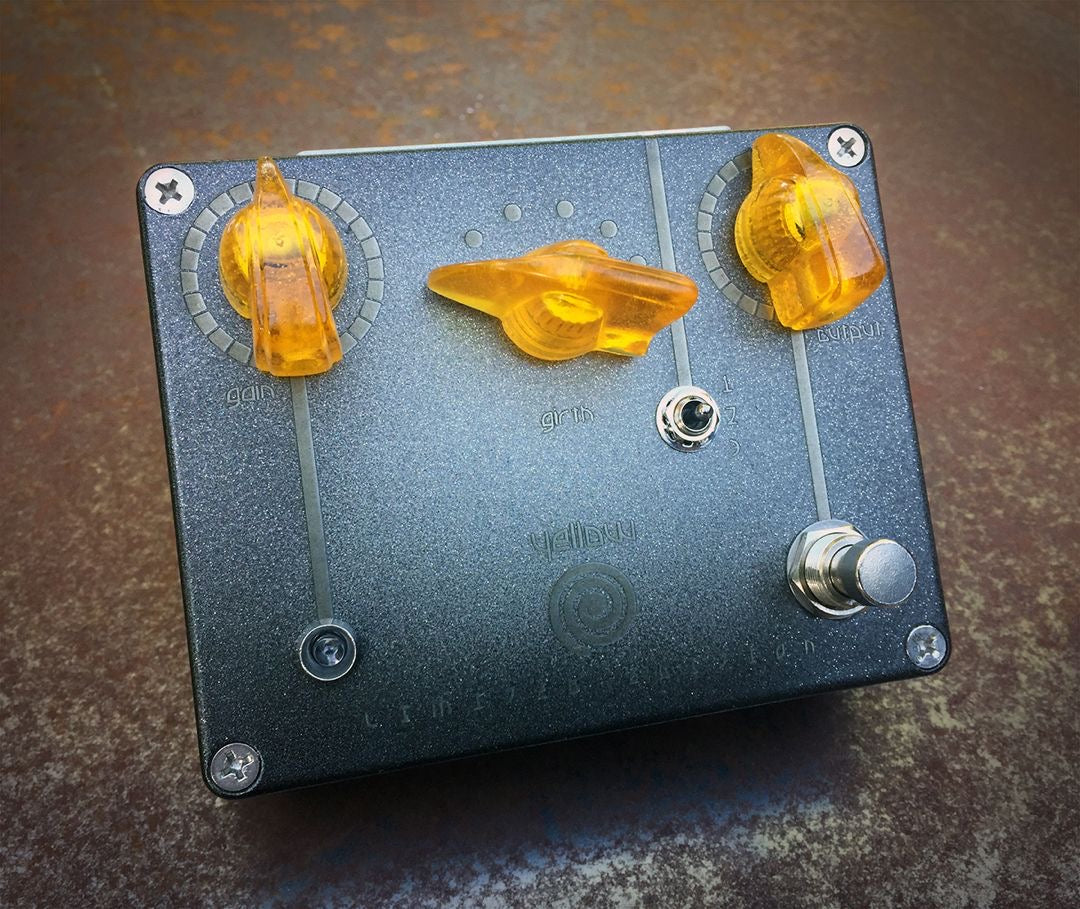Corrosion Ltd. Ed. Allora High-Gain Darlington Fuzz
- In stock, ready to ship
- Backordered, shipping soon
Same great sound; limited edition Corrosion look.
The Allora has its beginnings in requests from players to make a higher-gain version of the Brute. To explore this path I started experimenting with Darlington transistors. These transistors have incredibly high Hfe measurements in the 10’s of thousands, as opposed to the low-to mid hundreds of normal transistors. I’m using two Darlington’s in the Allora, and this amount of gain required substantial reworking of the input, output, and Detail controls; as well as reconfiguring the overall transistor arrangement (BC108C, BC549, MPSA12’s, 2N5089). I also opened up the Bias control to increase gating so that you can control noise, or not!
However, all of this experimentation and adjusting did not yield a “higher-gain version of the Brute,” it turned into - something else. The Allora is more compressed, wilder, ruder, feeds-back, sputters, sags, spits, woofs, growls, and even horns(?), like no other fuzz I make. Some settings remind me of a Muff, other settings remind me of a Buzzaround.
The Allora LOVES to be paired with a loud amp, and the generous Output allows it to hit the front end of an amp pretty hard - unity is right around noon. The Focus Toggle allows you to shave off some low-end to make it play nice with an already dirty amp channel. The three-way Texture toggle has the following options:
1 - Silicon 1N914 diodes
2 - Blower (straight transistor tone)
3 - Special
The first setting uses diodes that Christopher from SHOE turned me on to. They are common silicon diodes, but the breakup is nice and smooth with a little added compression. We use these diodes on the Red Spiral.
The second Blower setting is something that I started doing on a few one-off that I have come to love. It is just the straight raw tone of the transistors clipping.
The third setting is a part that I discovered that scoops a tiny bit of the lower-mids, this allows for a smoother tonal transition between fuzzy and “clean” when using the guitar volume knob. At higher-gain this setting tends to resolve to the upper octave, which is great for feedback.
A note or two about the expanded Bias control:
I increased the range on the bias to help control some of the inherent noise that comes with the increased gain of the Darlington transistors. Right around 2:00 on the Bias you can hear the gating kick-in and the noise floor is drastically improved. If the gating cuts-off your sustain too abruptly, try moving the Bias back just a little, you will find a sweet-spot depending upon your guitar pickups that is a good balance between gating and sustain.
Or you can just mess with the Bias to find all kinds of crazy sounds, noise be damned! For horn-like sounds where your pick attack is completely removed, try the 4:00 range on the Bias. For aggressive, more OD-ish sounds keep the Bias in the 11:00 range.
Ironically, one of my favorite settings on the Allora is lower-gain. Set the Output in the 3:00 range so it acts like a boost, then bring up the Gain and Bias to around 10:00-11:00 to “fill-out” the sound. This setting sounds phenomenal with an amp channel that is on the verge of break-up. I use this setting a lot on both my AC30 and Thunderverb 50 to get a great clear rhythm grind.
To sum up, the Allora is a bit different from the fuzzes I normally gravitate to. It isn’t “open” or “transparent” in any way. It wants to do what it wants to do, and you kind of have to ride the wave.








